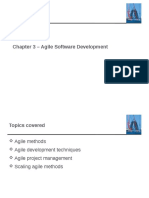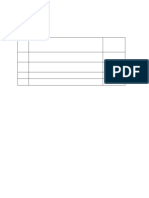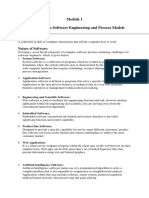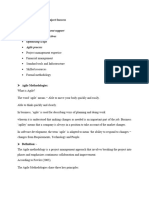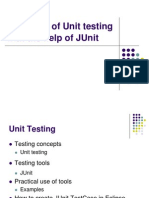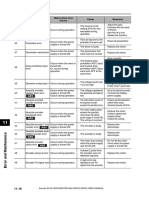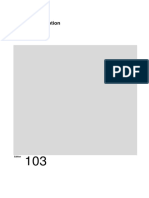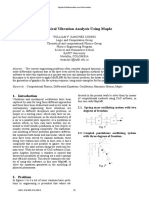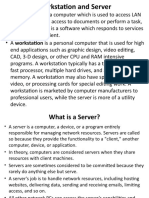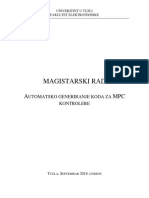OOAD Lecture 3
OOAD Lecture 3
Uploaded by
M AliCopyright:
Available Formats
OOAD Lecture 3
OOAD Lecture 3
Uploaded by
M AliCopyright
Available Formats
Share this document
Did you find this document useful?
Is this content inappropriate?
Copyright:
Available Formats
OOAD Lecture 3
OOAD Lecture 3
Uploaded by
M AliCopyright:
Available Formats
Object Oriented Analysis
and Design
DEPARTMENT OF INFORMATION TECHNOLOGY
GOVT. GORDON COLLEGE RAWALPINDI
Fall 2019 Semester
BS Course: IT-325 OOA/D
Course Instructor: Mubashra Rabbani
Lecture 2
Iterative/Evolutionary Development
Early programming and testing of a partial system, in
repeating cycles.
Development starts before all the requirements are defined
in detail.
Feedback is used to clarify and improve the evolving
specifications.
We rely on short quick development steps, feedback and
adaptation to clarify the requirements and design.
RATHER THAN
Big, upfront speculative requirements and design steps
before programming.
Early mitigation of risks.
Early visible progress
Higher success and productivity rates and lower defect levels
Iterative development
Iterative Development Example
Project
3 week early iteration
Morning kickoff meeting – clarification of tasks and goals of
the iteration
Reverse Engineering of last iteration into UML Diagrams
Then team spends rest of the day working at whiteboards
(agile modeling)
Sketching of rough UML diagrams, writing pseudocode and
design notes.
Then remaining days are spent on implementation, testing,
further design, integration and daily builds of partial system.
Activities meanwhile: Demonstration and evaluations with
stakeholders, ad planning for next iteration
Iterative Development
Neither rush to code, nor long drawn-out design steps – just a little
forethought.
Result of each iteration is executable but incomplete system.
Output of an iteration is not an experimental or throw away prototype.
Rather, the output is a production-grade subset of the final system.
Iterative feedback and evolution leads towards the desired system.
Requirements and design stability lowers overtime.
Timeboxing of iterations (fixed length)
Delayed feedback misses the point of iterative development.
Small steps, rapid feedback, adaptation
Agile
AGILE : Agile is the ability to create and respond to change.
It is a way of dealing with, and ultimately succeeding in, an
uncertain and turbulent environment.
Agile processes generally promote a disciplined project
management process that encourages frequent inspection
and adaptation where requirements and solutions evolve as
we proceed using incremental development process.
Effective Response to change
Effective communication among all stake holders
Drawing the customers onto the team
Rapid, incremental delivery of product
Agile
Agile software development is an umbrella term for a set of
frameworks and practices based on the values and principles
expressed in the Agile Manifesto.
AGILE MENIFESTO : the Manifesto was developed by a group
of leading figures in the software industry, and reflects their
experience of what approaches do and do not work for
software development.
Individuals and interactions over processes and tools
Working software over comprehensive documentation
Customer collaboration over contract negotiation
Respond to change over following a plan
13 principals of Agile Manifesto reflect this manifesto.
Agile
Agile software development refers to software development
methodologies centered round the idea of iterative
development.
Driven by customer descriptions
Short lived plans
Iterative development
Multiple software increments are delivered
Adaptation of change
Unified Process
The unified process model is an iterative, incremental,
architecture-centric, and use-case driven approach to software
development.
Use-Case Driven Approach
Means that development process follows a flow derived from use
cases
A use-case defines the interaction between two or more entities.
requirements by a customer are converted to functional
requirements by an analyst and generally referred to as use-cases.
A use-case describes the operation of a software as interactions
between the customer and the system, resulting in a specific output
or a measurable return.
For example, the online cake shop can be specified in terms of use
cases such as 'add cake to cart,' 'change the quantity of added
cakes in cart,' 'cake order checkout,' and so on.
Each use case represents a significant functionality and could be
considered for an iteration.
Unified Process
Architecture-centric Approach
Architecture is view of the whole system with characteristics
made more visible by leaving the details aside.
Using this approach, you'd be creating a blueprint of the
organization of the software system.
It would include taking into account the different technologies,
programming languages, operating systems, development and
release environments, server capabilities, and other such areas
for developing the software.
Architecture represents the form f the system, use cases
represent the function.
To find the form, architects work with a general understanding
of the key functions
Unified Process
Iterative And Incremental Approach
Iteration refers to steps in the workflow, and increments, to
growth in the product.
In every situation
Developers identify and specify relevant use cases.
Create a design using the chosen architecture.
Implement design as components.
Verify the components satisfy the use cases.
You'd develop the software as a number of small mini-projects,
working in cycles and small working versions of the software will
be developed at the end of each cycle.
Each iteration would add some functionality to the software
according to the requirements specified by the customer.
Phases Of UP Model
We'll go through the four different phases, one at a time:
Inception: The inception phase is similar to the requirements collection and analysis
stage of the waterfall model of software development. In this phase, you'd collect
requirements from the customer and analyze the project's feasibility, its cost, risks, and
profits.
Elaboration: In this phase, you'd be expanding upon the activities undertaken in the
inception phase. The major goals of this phase include creating fully functional
requirements (use-cases) and creating a detailed architecture for fulfillment of the
requirements. You'd also prepare a business case document for the customer.
Construction: In this phase, you'd be writing actual code and implementing the
features for each iteration. You'd be rolling out the first iteration of the software
depending on the key use-cases that make up the core functionalities of the software
system.
Transition: In this phase, you'd be rolling out the next iterations to the customer and
fixing bugs for previous releases. You would also deploy builds of the software to the
customer.
You might also like
- Question & Answers: Certified in Cybersecurity (CC)Document6 pagesQuestion & Answers: Certified in Cybersecurity (CC)Arif100% (4)
- LEcture 3 SDLC - Iterative ModelDocument30 pagesLEcture 3 SDLC - Iterative ModelSalman ShafiqNo ratings yet
- SE Uquestion Bank 1 41Document41 pagesSE Uquestion Bank 1 41pikachudoremon99No ratings yet
- Specialized Project Models and Agile Process DevelopmentDocument8 pagesSpecialized Project Models and Agile Process DevelopmentPranay MahadikNo ratings yet
- Agile ModelDocument18 pagesAgile ModelMeghnadhNo ratings yet
- SE NotesDocument11 pagesSE NotesSateeshNo ratings yet
- International Journal of Computational Engineering Research (IJCER)Document7 pagesInternational Journal of Computational Engineering Research (IJCER)International Journal of computational Engineering research (IJCER)No ratings yet
- Unit-2, SPMDocument46 pagesUnit-2, SPMAkshay DwivediNo ratings yet
- Chapter 3 Agile SW DevDocument66 pagesChapter 3 Agile SW DevAlma HodzicNo ratings yet
- Software EngineeringDocument8 pagesSoftware Engineeringnigamshreya2004No ratings yet
- 1.software DevelopmentDocument6 pages1.software DevelopmentAna Pociello SamperizNo ratings yet
- Lecture2 ProcessModelsDocument31 pagesLecture2 ProcessModelsjawwad_noamanNo ratings yet
- FSeng Chapter 3 - Agile DevelopmentDocument18 pagesFSeng Chapter 3 - Agile DevelopmentSura OGNo ratings yet
- Lecture 02Document66 pagesLecture 02Jooo loNo ratings yet
- Software Engineering (Se-207) : 1) AnalysisDocument30 pagesSoftware Engineering (Se-207) : 1) AnalysisWaqar GulNo ratings yet
- Illustrate The Umbrella Activities of A Software ProcessDocument12 pagesIllustrate The Umbrella Activities of A Software ProcessGautham SajuNo ratings yet
- Devops RecordDocument110 pagesDevops RecordSailaja SailuNo ratings yet
- IEEE Defines Software Engineering As:: The Term Software Engineering Is Composed of Two Words, Software and EngineeringDocument8 pagesIEEE Defines Software Engineering As:: The Term Software Engineering Is Composed of Two Words, Software and EngineeringNaeem ShaikhNo ratings yet
- Soniya Hariramani - Advance Software Engineering IADocument9 pagesSoniya Hariramani - Advance Software Engineering IAsoniya hariramaniNo ratings yet
- Unit I - OOSEDocument12 pagesUnit I - OOSEDivya BNo ratings yet
- Software DevelopmentDocument3 pagesSoftware DevelopmentJojo Conceso EllaNo ratings yet
- Unit 1Document19 pagesUnit 1Rajyalakshmi KolliparaNo ratings yet
- Managing Software Development: Debra Lee Davis, M.S., M.A., PH.DDocument46 pagesManaging Software Development: Debra Lee Davis, M.S., M.A., PH.DDebra DavisNo ratings yet
- SEN Important Question: 1) Describe The Layered Technology Approach of Software EngineeringDocument49 pagesSEN Important Question: 1) Describe The Layered Technology Approach of Software EngineeringNilam adhavNo ratings yet
- Lecture-2Document35 pagesLecture-2mh7156168No ratings yet
- OOSEDocument100 pagesOOSESuriyapriya NNo ratings yet
- SE Module1Document25 pagesSE Module1116TanzeelNo ratings yet
- SDLCDocument81 pagesSDLCمحمد احمدNo ratings yet
- Evolutionary Software Process ModelDocument5 pagesEvolutionary Software Process ModelRakesh InjamNo ratings yet
- SDLC NotesDocument8 pagesSDLC Notesrushty decenaNo ratings yet
- Software Engineering Lecture 1.1.5Document8 pagesSoftware Engineering Lecture 1.1.5Ashutosh mishraNo ratings yet
- Best Practices Software ModelsDocument16 pagesBest Practices Software ModelsAarthi ENo ratings yet
- Chapter 1Document57 pagesChapter 1Sourabh RautNo ratings yet
- Neww SSSRRRTTTT PDFDocument1 pageNeww SSSRRRTTTT PDFkaranpatil488pistaNo ratings yet
- Unit 1Document15 pagesUnit 1Ahmed KhanNo ratings yet
- Software EngineeringDocument33 pagesSoftware EngineeringFozia KhanNo ratings yet
- INTRODUCTION TO SOFTWARE ENGINEERING NOTE - docxEDITED.docx2Document11 pagesINTRODUCTION TO SOFTWARE ENGINEERING NOTE - docxEDITED.docx2Grace ErinoshoNo ratings yet
- SA Practical CS-701Document23 pagesSA Practical CS-701ThorNo ratings yet
- SE 15queDocument20 pagesSE 15que230493131036.kashishNo ratings yet
- Se-3 (Sharath Vtu)Document20 pagesSe-3 (Sharath Vtu)ajithkumarbme2025No ratings yet
- Week 2 - Software DVT MethodologiesDocument10 pagesWeek 2 - Software DVT MethodologiesmuyajohntyNo ratings yet
- Agile Model in Software EngineeringDocument5 pagesAgile Model in Software EngineeringSonia AroraNo ratings yet
- RPL - Week 2 - Software ProcessDocument24 pagesRPL - Week 2 - Software ProcessSohuturon Fernando NapitupuluNo ratings yet
- Software ModelsDocument6 pagesSoftware Modelsbhoomikaolekar1618No ratings yet
- Software Engineering Concepts E: FacultyDocument40 pagesSoftware Engineering Concepts E: FacultyAnchalNo ratings yet
- Evolution of V-Agile ModelDocument7 pagesEvolution of V-Agile ModelaliNo ratings yet
- Mini AssignmentzzzDocument6 pagesMini AssignmentzzzAung Kaung MawNo ratings yet
- SEN VIMP Topics With AnswerDocument50 pagesSEN VIMP Topics With Answerkaranbankar54No ratings yet
- Software EngineeringDocument4 pagesSoftware EngineeringxyzahmadsspamNo ratings yet
- Definitions: Software Is More Than Just A Program Code. A Program Is An Executable Code, Which ServesDocument22 pagesDefinitions: Software Is More Than Just A Program Code. A Program Is An Executable Code, Which Servessusovan garaiNo ratings yet
- Iterative Software Development MethodologyDocument7 pagesIterative Software Development MethodologySora Boru GuyoNo ratings yet
- Introduction To Software EngineeringDocument10 pagesIntroduction To Software Engineeringgd2782001No ratings yet
- Soft Eng 1 - Chapter No 2-2Document23 pagesSoft Eng 1 - Chapter No 2-2Hayat HytNo ratings yet
- SE-101 (Exam)Document8 pagesSE-101 (Exam)Kaung Khant LinNo ratings yet
- Software Engineering - Unit - 1Document22 pagesSoftware Engineering - Unit - 1Naveen IdxNo ratings yet
- Lecture 1Document22 pagesLecture 1Lyba SiddiquiNo ratings yet
- Software Testing TechniquesDocument191 pagesSoftware Testing TechniquesAnant MoreNo ratings yet
- Iterative and Incremental Development StylesDocument8 pagesIterative and Incremental Development StylesShalineeNo ratings yet
- SPM Unit-2ndDocument24 pagesSPM Unit-2ndakshan09061999No ratings yet
- Ics - Chapter 1 - Exercise - ObjectiveDocument4 pagesIcs - Chapter 1 - Exercise - ObjectivesharifahnurNo ratings yet
- JunIt TestingDocument51 pagesJunIt TestingUdayan DattaNo ratings yet
- 11-4 Troubleshooting: Alarm Display Error Conditions Status When Error Occurs Cause MeasuresDocument1 page11-4 Troubleshooting: Alarm Display Error Conditions Status When Error Occurs Cause MeasuresDominique KomeyNo ratings yet
- Antimalware Scan Interface Bypasses DetDocument18 pagesAntimalware Scan Interface Bypasses DetBenNo ratings yet
- ICL700 DescriptionDocument113 pagesICL700 DescriptionAdriano Vargas VieiraNo ratings yet
- NC7WZ07 ONSemiconductorDocument11 pagesNC7WZ07 ONSemiconductorsanchezmartellsNo ratings yet
- Maple SAM-04Document6 pagesMaple SAM-04Leo KutsNo ratings yet
- Java Developer ResumeDocument6 pagesJava Developer Resumeafaybjktm100% (3)
- Fiot Unit 3Document50 pagesFiot Unit 3Anusha Penchala100% (1)
- Crystal Report JS Develop GuideDocument38 pagesCrystal Report JS Develop Guide한정우No ratings yet
- 0803 X2 VDR and S-VDR User Manual Iss01 Rev08Document56 pages0803 X2 VDR and S-VDR User Manual Iss01 Rev08Ornardys PenicheNo ratings yet
- Composite SAP Note: Rapid Activation For SAP Fiori in SAP S/4HANA 2021Document7 pagesComposite SAP Note: Rapid Activation For SAP Fiori in SAP S/4HANA 2021Amit Gupta0% (1)
- Network Devices (Hub, Repeater, Bridge, Switch, Router, Gateways and Brouter)Document3 pagesNetwork Devices (Hub, Repeater, Bridge, Switch, Router, Gateways and Brouter)Roxanne EspirituNo ratings yet
- A Review Paper On Communicating GlovesDocument5 pagesA Review Paper On Communicating GlovesInternational Journal of Innovative Science and Research TechnologyNo ratings yet
- Free Journal ListDocument12 pagesFree Journal ListSatyam SaxenaNo ratings yet
- Move Your Business Forward With Chrome Enterprise UpgradeDocument2 pagesMove Your Business Forward With Chrome Enterprise UpgradePixieNo ratings yet
- Ip pb1 QP Ms Agra Set ADocument17 pagesIp pb1 QP Ms Agra Set AMayank MishraNo ratings yet
- Case 3 - An Organization That Wanted To Secure Acce...Document4 pagesCase 3 - An Organization That Wanted To Secure Acce...Muhammad FrazNo ratings yet
- Electronic Data ProcessingDocument11 pagesElectronic Data ProcessingNCS Education System PeshawarNo ratings yet
- Using The Developer Console To Execute Apex CodeDocument5 pagesUsing The Developer Console To Execute Apex Codeksr131No ratings yet
- GUIDES IMD310 - Version 1 (1 Januray 2024)Document12 pagesGUIDES IMD310 - Version 1 (1 Januray 2024)Ain FdNo ratings yet
- Job Title: DC Network Engineer: Role PurposeDocument1 pageJob Title: DC Network Engineer: Role PurposeAdelin FrumusheluNo ratings yet
- 2024 SSCP Detailed Content Outline With Weights Public Use OnlyDocument4 pages2024 SSCP Detailed Content Outline With Weights Public Use OnlyBlanchard KOUASSINo ratings yet
- Ontap CDocument16 pagesOntap CMinh ThuậnNo ratings yet
- Workstation and ServerDocument11 pagesWorkstation and ServerAditi sharmaNo ratings yet
- Using Oracle Autonomous Database Serverless 61 70Document10 pagesUsing Oracle Autonomous Database Serverless 61 70hammadyazan16No ratings yet
- Harnessing The Power of SAP Query: Part I: The BasicsDocument67 pagesHarnessing The Power of SAP Query: Part I: The Basicsearnestgoh3635No ratings yet
- What Are The Issues and Technical Alternatives To Be Considered When Developing International Information Systems?Document2 pagesWhat Are The Issues and Technical Alternatives To Be Considered When Developing International Information Systems?Georgia VasanthaNo ratings yet
- Master RadDocument53 pagesMaster RadMelisa HodzicNo ratings yet








